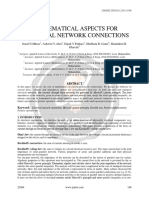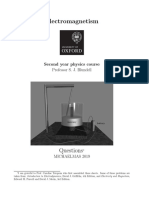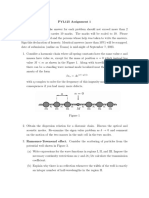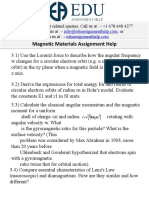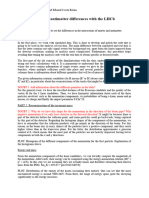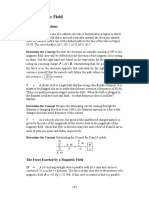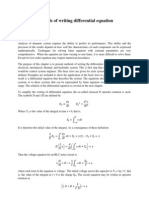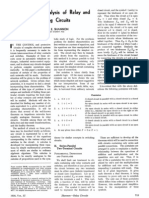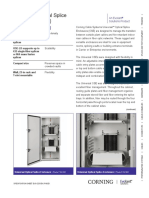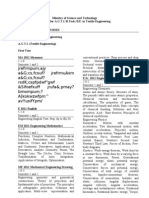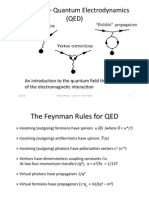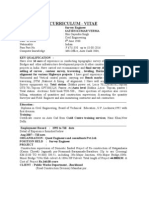Ph304 Problem Set 3 Electrodynamics: Princeton University
Ph304 Problem Set 3 Electrodynamics: Princeton University
Uploaded by
gadas11Copyright:
Available Formats
Ph304 Problem Set 3 Electrodynamics: Princeton University
Ph304 Problem Set 3 Electrodynamics: Princeton University
Uploaded by
gadas11Original Title
Copyright
Available Formats
Share this document
Did you find this document useful?
Is this content inappropriate?
Copyright:
Available Formats
Ph304 Problem Set 3 Electrodynamics: Princeton University
Ph304 Problem Set 3 Electrodynamics: Princeton University
Uploaded by
gadas11Copyright:
Available Formats
Princeton University
Ph304 Problem Set 3 Electrodynamics
(Due 5 pm, Thursday Feb. 27, 2003 in Matt Sullivans mailbox, Jadwin atrium)
Instructor: Kirk T. McDonald, Jadwin 309/361, x6608/4398 kirkmcd@princeton.edu http://puhep1.princeton.edu/mcdonald/examples/ AI: Matthew Sullivan, 303 Bowen Hall, x8-2123 mtsulliv@princeton.edu Problem sessions: Sundays, 7 pm, Jadwin 303 Text: Introduction to Electrodynamics, 3rd ed. by D.J. Griths (Prentice Hall, ISBN 0-13-805326-X, now in 6th printing) Errata at http://academic.reed.edu/physics/faculty/griths.html
Princeton University 2003
Ph304 Problem Set 3
Reading: Griths secs. 3.3-3.4, 4.1-4.2. 1. Griths prob. 3.15. 2. Extended version of Griths prob. 3.23. Show that the general form of solutions to Laplaces equation, 2 V = 0, in cylindrical coordinates (r, , z) when there is no z dependence is V (r, ) = (a0 + b0 ln r)(c0 + d0 ) +
k
ak r k +
bk dk cos k + ck rk + k sin k . rk r
If the region of interest includes 0 2, show that the indices k are the positive integers. Use this expansion to motivate an image method for the problem of a line charge per meter at position (r, ) = (b, 0) in the presence of a grounded conducting cylinder of radius a < b, whose axis is the z axis. We hope that a solution exists in which the eect of the conducting cylinder on the region r > a is the same as that of an imaginary line charge per meter placed at some suitable radius c < a. While you are welcome to carry out a solution in which all the Fourier coecients are explicitly evaluated, this is not necessary to achieve the goal of deducing the image method. First, write down the form of the potential for the wire alone, for both r < b and r > b, noting that some Fourier coecients must by zero by symmetry arguments. It is helpful to write the radial dependence in terms of the scaled variable r/b rather than r alone. Likewise, write down the form of the potential due to the conducting cylinder for r > a, which will have the same symmetries at the potential of the wire, since the potential of the cylinder is induced by that of the wire. Then, since the total potential vanishes at r = a, one nds a simple relation between the potential due to the cylinder and that of the wire namely, an image prescription. The potential of a 2-dimensional charge distribution not including the z axis must be nite at this axis, but can have a logarithmic divergence as r . With care you can include terms in ln r in appropriate places in your expansions of the potentials of the wire and the cylinder, to nd that the coecients of these terms obey the same transformation as do the other terms of the expansions. Not for credit: you might wish to construct the image method directly, in the spirit of Griths Ex. 3.2. Experts will also note that 2-D solutions to Laplaces equation are expressible in terms of a function of a complex variable, which have useful application to problems of line charges and cylinders. See, for example, Chap. 4 of Static and Dynamic Electricity by W.R. Smythe (McGraw-Hill, 1968). 3. Griths prob. 3.37. Without loss of generality, set the potential V0 of the conducting sphere to zero. Griths recommends this problem be solved by separation of variables in spherical coordinates. Since the free charge distribution varies as P1 (cos ), the only terms in the Legendre polynomial expansion will be those in P1 . Further, if you write
Princeton University 2003
Ph304 Problem Set 3
the potential with normalized radial coordinates, then continuity of the potential at r = b tells us that there are only two unknown expansion coecients, A1 and B1 :
r b V (a < r < b) = A1 + B1 b r V (r > b) = C1 b r
2
P1 (cos ),
2
b P1 (cos ) = (A1 + B1 ) r
P1 (cos ).
Then, since V (a) = 0, there is really only one unknown.... However, this problem is also susceptible to treatment by the image method! Carefully deduce the image charge density on the appropriate image sphere. As both charge densities and vary as cos = P1 (cos ), both of these charge distributions have only dipole moments. Hence you should be able to quickly write down the potential both for r > b, and for a < r < b, recalling from Ex. 3.9 that the eld inside a cos charge distribution is uniform. This last remark oers a third way to solve this problem. Since the electric eld must vanish inside the conductor for r < a, a surface charge must be induced at r = a whose interior eld exactly cancels the interior eld from the given charge distribution at r = b. Show that deduced this way is the same as that obtained from the potential that you have previously calculated. 4. Griths prob. 3.40. 5. Griths prob. 3.41. 6. Griths prob. 3.44. Since conductors are equipotentials, the integrals mentioned in the statement of Greens reciprocity theorem in prob. 3.43 lead to the total charges on the conductors. Hence, this theorem is more often stated as: if a set {i} of conductors is at potentials Vi when charges Qi are placed on them, and instead charges Qi would result in potentials Vi , then Qi Vi = Qi Vi .
i i
A useful trick is to consider a point charge as residing on a tiny conductor, so that in a second scenario with the same conductors, the amount of the charge on this tiny conductor can be set to zero, and this conductor will take on the potential that would exist at the position of the absent charge. Greens reciprocity theorem can be used to deduce charge distributions on conductors by imagining those conductors to be suitably subdivided. For an example of such a procedure, see prob. 4, Ph501 Set 4, which is presented separately at http://puhep1.princeton.edu/mcdonald/examples/straw.pdf
You might also like
- Anschp 10Document20 pagesAnschp 10Juan Battini71% (7)
- Raymarine E-Series Service ManualDocument56 pagesRaymarine E-Series Service ManualXesnova DevelopmentNo ratings yet
- Bill of Materials FIRE PRODocument5 pagesBill of Materials FIRE PROalain lanaNo ratings yet
- Parte 2 Fundamentos Electromagneticos Con Matlab - Lonngren & SavovDocument354 pagesParte 2 Fundamentos Electromagneticos Con Matlab - Lonngren & SavovAlbert HernándezNo ratings yet
- Problem Set Electrostatics BasicsDocument3 pagesProblem Set Electrostatics BasicsJohnHiccupNo ratings yet
- Physics 370 Final Exam Solution Hints Spring Semester 2012 (Study Guide Version)Document13 pagesPhysics 370 Final Exam Solution Hints Spring Semester 2012 (Study Guide Version)Χρίστος ΠαπαναστασίουNo ratings yet
- Scattering and Bound States For A Class of Non-Central PotentialsDocument22 pagesScattering and Bound States For A Class of Non-Central PotentialsDANIEL ALEJANDRO BONILLA MORENONo ratings yet
- Radiation IntegralsDocument22 pagesRadiation IntegralsrajeshadktNo ratings yet
- Numerical Modeling of Space-Charge-Limited Charged-Particle Emission On A Conformal Triangular MeshDocument19 pagesNumerical Modeling of Space-Charge-Limited Charged-Particle Emission On A Conformal Triangular MeshPatrick L. GoesNo ratings yet
- Spring 2008 P 2Document5 pagesSpring 2008 P 2paimoNo ratings yet
- Fermi Math - Proc.cambridge - Phil.soc.1930Document11 pagesFermi Math - Proc.cambridge - Phil.soc.1930leendert_hayen7107No ratings yet
- Validity Check of Mutual Inductance Formulas For Circular Filaments With Lateral and Angular Misalignments S. I. Babic PIER M 2009Document12 pagesValidity Check of Mutual Inductance Formulas For Circular Filaments With Lateral and Angular Misalignments S. I. Babic PIER M 2009Cristian LiviuNo ratings yet
- Solution To The Static Charge Distribution On A Thin Wire Using The Method of MomentsDocument8 pagesSolution To The Static Charge Distribution On A Thin Wire Using The Method of MomentsLissete VergaraNo ratings yet
- Lecture Notes Chapter 1Document39 pagesLecture Notes Chapter 1zaitulNo ratings yet
- The Even - and Odd-Mode Capacitance Parameters For Coupled Lines in Suspended SubstrateDocument8 pagesThe Even - and Odd-Mode Capacitance Parameters For Coupled Lines in Suspended SubstrateSam SomarithNo ratings yet
- Capacitive Sensors With Pre-Calculable Capacitance: Stanislav ĎaďoDocument6 pagesCapacitive Sensors With Pre-Calculable Capacitance: Stanislav ĎaďoabasakNo ratings yet
- MATHEMATICAL ASPECTS FOR ELECTRICAL NETWORK CONNECTIONS Ijariie22404Document6 pagesMATHEMATICAL ASPECTS FOR ELECTRICAL NETWORK CONNECTIONS Ijariie22404sonal Nanasaheb mhaseNo ratings yet
- Claus Kiefer and Erik A Martfnez - On Time and The Quantum-To-Classical Transition in Jordan-Brans-Dicke Quantum GravityDocument9 pagesClaus Kiefer and Erik A Martfnez - On Time and The Quantum-To-Classical Transition in Jordan-Brans-Dicke Quantum GravityTuoma2No ratings yet
- Problem Set 4: Solutions: U A Department of Physics and Astronomy PH 106-4 / Leclair Fall 2008Document7 pagesProblem Set 4: Solutions: U A Department of Physics and Astronomy PH 106-4 / Leclair Fall 2008Angel Daniel PalaciosNo ratings yet
- Physics II ProblemsDocument1 pagePhysics II ProblemsBOSS BOSSNo ratings yet
- 6th Lecture Electrostatic Field in InsulatorsDocument10 pages6th Lecture Electrostatic Field in InsulatorsPhani PhaniNo ratings yet
- Em Questions 2019Document20 pagesEm Questions 2019MartinaGmizaNo ratings yet
- Electromagnetism II: Electricity: 1 The Method of ImagesDocument15 pagesElectromagnetism II: Electricity: 1 The Method of ImagesJoshua 10 nNo ratings yet
- Test 13 CH 1,2 and 3Document8 pagesTest 13 CH 1,2 and 3yajatmlk1619No ratings yet
- Self Inductance of A Wire Loop As A Curve IntegralDocument15 pagesSelf Inductance of A Wire Loop As A Curve IntegralRichard SmithNo ratings yet
- Assignment PotentialDocument4 pagesAssignment Potentialshruti baruaNo ratings yet
- Lect 15Document13 pagesLect 15Girish RoyNo ratings yet
- Electrostatics: Electric Field & Potential: Example 1: Two Intersecting and Oppositely Charged SpheresDocument11 pagesElectrostatics: Electric Field & Potential: Example 1: Two Intersecting and Oppositely Charged SpheresgopalNo ratings yet
- Aula 3 - Teoria de Cordas MITDocument7 pagesAula 3 - Teoria de Cordas MITErick MouraNo ratings yet
- Lecture 06Document39 pagesLecture 06همام التريكيNo ratings yet
- Foundations:Strip FootingsDocument41 pagesFoundations:Strip FootingsJuan José Apellidouno ApellidodosNo ratings yet
- Solutions of Electrostatic ProblemsDocument16 pagesSolutions of Electrostatic ProblemsMochamad Rizal JauhariNo ratings yet
- Aperture Coupling - HarringtonDocument24 pagesAperture Coupling - HarringtonPavelVilnerNo ratings yet
- Assignment 1Document2 pagesAssignment 1TimbleNo ratings yet
- Resistor Network Aproach EITDocument55 pagesResistor Network Aproach EITjorgeluis.unknownman667No ratings yet
- Magnetic Materials Assignment HelpDocument15 pagesMagnetic Materials Assignment HelpEdu Assignment Help100% (1)
- 2020 Set 3Document34 pages2020 Set 3Giridhar MeruvalaNo ratings yet
- Module III: Relativistic ED: Applications: Lectures 12-13: Radiation Reaction ForceDocument20 pagesModule III: Relativistic ED: Applications: Lectures 12-13: Radiation Reaction ForcemicrodotcdmNo ratings yet
- Power System Analysis: Development of Transmission Line Models Tom Overbye and Ross BaldickDocument29 pagesPower System Analysis: Development of Transmission Line Models Tom Overbye and Ross Baldickصدام حسینNo ratings yet
- A Transformer Model For Winding Fault StudiesDocument10 pagesA Transformer Model For Winding Fault StudiesMariazinhaJoaquinaNo ratings yet
- Report DraftDocument16 pagesReport DraftEdu CostaNo ratings yet
- Capitulo 26 TiplerDocument22 pagesCapitulo 26 TiplerHamzaAouidatNo ratings yet
- 2 PHDocument8 pages2 PHalamryzhra62No ratings yet
- Nuclear Astrophysics: Shawn - Bishop@ph - Tum.deDocument42 pagesNuclear Astrophysics: Shawn - Bishop@ph - Tum.deJ Jesús Villanueva GarcíaNo ratings yet
- Lecture 5 Electrons in Weak Periodic PotentialDocument8 pagesLecture 5 Electrons in Weak Periodic PotentialSarbajitMannaNo ratings yet
- Handout09 A2 UsefulDocument5 pagesHandout09 A2 UsefulJoyee BasuNo ratings yet
- A. Mikovic - Quantum Gravity Vacuum and Invariants of Embedded Spin NetworksDocument11 pagesA. Mikovic - Quantum Gravity Vacuum and Invariants of Embedded Spin NetworksArsLexiiNo ratings yet
- LN-5 Radiation Integrals and Auxiliary Potential FunctionsDocument11 pagesLN-5 Radiation Integrals and Auxiliary Potential Functionsomar zanganaNo ratings yet
- Laplace's and Poisson's EquationDocument4 pagesLaplace's and Poisson's EquationKartiko Rusdianto100% (1)
- Statistical Mechanics Lecture Notes (2006), L13Document7 pagesStatistical Mechanics Lecture Notes (2006), L13OmegaUserNo ratings yet
- Lecture 06Document40 pagesLecture 06Reddyvari VenugopalNo ratings yet
- Ward-1983-Completely Solvable Gauge-FieldDocument16 pagesWard-1983-Completely Solvable Gauge-FieldGuido FranchettiNo ratings yet
- Last Time We Discussed: Electric Field of Traveling Plane Wave. Phase SpaceDocument10 pagesLast Time We Discussed: Electric Field of Traveling Plane Wave. Phase SpaceOliver58No ratings yet
- Lecture11 Chap6Document42 pagesLecture11 Chap6minc727No ratings yet
- Y Y ZXXJ Y Y Yna: ReferencesDocument3 pagesY Y ZXXJ Y Y Yna: ReferencesDaniel Herrera AstudilloNo ratings yet
- 2020 Set 4Document34 pages2020 Set 4Giridhar MeruvalaNo ratings yet
- 09 Radicion Devido A UHVTL PDFDocument5 pages09 Radicion Devido A UHVTL PDFleriomNo ratings yet
- Methods of Writing Differential EquationDocument9 pagesMethods of Writing Differential EquationDillah UtamaNo ratings yet
- Spring 2007 Qualifying Exam: - 34 - 34 B - 23 - 19 A 23 8 e - 31 P - 27 N - 27 0 - 11 C e - 12 0 - 7 2 0 0 2 - 11 3 2Document5 pagesSpring 2007 Qualifying Exam: - 34 - 34 B - 23 - 19 A 23 8 e - 31 P - 27 N - 27 0 - 11 C e - 12 0 - 7 2 0 0 2 - 11 3 2paimoNo ratings yet
- SH Ann OnDocument11 pagesSH Ann OnwaltzaNo ratings yet
- Problems in Quantum Mechanics: Third EditionFrom EverandProblems in Quantum Mechanics: Third EditionRating: 3 out of 5 stars3/5 (2)
- Understanding Vector Calculus: Practical Development and Solved ProblemsFrom EverandUnderstanding Vector Calculus: Practical Development and Solved ProblemsNo ratings yet
- Ultrasonic Machining (Usm)Document17 pagesUltrasonic Machining (Usm)Prasad ChikkamNo ratings yet
- Bruene Explanation V13Document19 pagesBruene Explanation V13lu1agpNo ratings yet
- 1.cover Page & Envelope CoverDocument7 pages1.cover Page & Envelope Coversujankhanal10No ratings yet
- Parts Catalog Cummins, NTA855-G4 - ESN 41289414 - CPL 3527Document115 pagesParts Catalog Cummins, NTA855-G4 - ESN 41289414 - CPL 3527Ronggo Tulank100% (5)
- Assemblage Poteau-Semelle IsoléeDocument9 pagesAssemblage Poteau-Semelle IsoléeFrancklinMeunierM'ondoNo ratings yet
- Catalogo InterrollDocument3 pagesCatalogo InterrollIgorXavierNo ratings yet
- Engineering Science - Dynamic Engineering SystemsDocument13 pagesEngineering Science - Dynamic Engineering SystemsSteven Goddard100% (1)
- Universal Optical Splice Enclosures (OSE) : Features and BenefitsDocument4 pagesUniversal Optical Splice Enclosures (OSE) : Features and BenefitsSergio Denis UCNo ratings yet
- ATMP FuelcatDocument4 pagesATMP FuelcatThinkDefenceNo ratings yet
- 07 - 3D Slope StabilityDocument14 pages07 - 3D Slope StabilityREMIER100% (1)
- 01 - Introduction To EssbaseDocument21 pages01 - Introduction To EssbaseMahesh PrasadNo ratings yet
- Iit DelhiDocument8 pagesIit DelhiVikash RaiNo ratings yet
- Database Management:: Ray R. Larson University of California, Berkeley School of Information Management and SystemsDocument51 pagesDatabase Management:: Ray R. Larson University of California, Berkeley School of Information Management and Systemshani1986yeNo ratings yet
- Email SecurityDocument13 pagesEmail SecuritymgnanasekarNo ratings yet
- Work Guide: TLA Original March 28th. 2014 Jt8D Engine ManualDocument4 pagesWork Guide: TLA Original March 28th. 2014 Jt8D Engine Manualjulian camilo rojas tovarNo ratings yet
- Gas Vapor MixturesDocument47 pagesGas Vapor MixturesMo SalihNo ratings yet
- Numpy Essentials PaperbackDocument2 pagesNumpy Essentials PaperbackTatjana KuburicNo ratings yet
- Iso 17025 Test Lab Manual DocumentsDocument11 pagesIso 17025 Test Lab Manual DocumentsSuresh Kumar80% (5)
- Lecture 4 - Quantum Electrodynamics (QED)Document14 pagesLecture 4 - Quantum Electrodynamics (QED)sid_senadheeraNo ratings yet
- CV S K VermaDocument7 pagesCV S K VermakulkshetraNo ratings yet
- 2-4 Brake: Automatic TransmissionDocument6 pages2-4 Brake: Automatic TransmissionAnton FortovNo ratings yet
- Differentiation IntegrationDocument23 pagesDifferentiation Integrationscribd downloadNo ratings yet
- CFFC STD CompletoDocument31 pagesCFFC STD CompletolcandoNo ratings yet
- Long Span StructuresDocument13 pagesLong Span StructuresVinay Katariya100% (1)
- Mem ItalyDocument4 pagesMem ItalysanjeevNo ratings yet
- Part 13-Level 2Document8 pagesPart 13-Level 2ammarmpNo ratings yet
- SD 3600-2e01Document9 pagesSD 3600-2e01EduardoSantosNo ratings yet
















